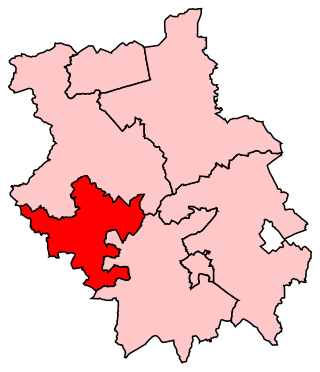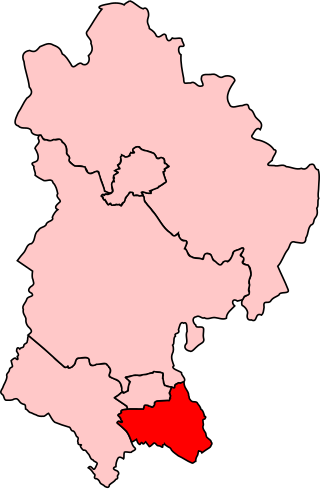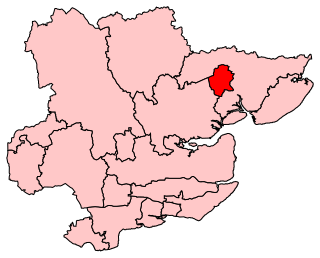Boundaries

The County Borough of Bury, the Borough of Radcliffe, and the Urban District of Tottington.
| Bury and Radcliffe | |
|---|---|
| Former Borough constituency for the House of Commons | |
| County | Lancashire, until 1974; Greater Manchester, from 1974 |
| Major settlements | Bury and Radcliffe |
| 1950–1983 | |
| Seats | One |
| Created from | Bury Heywood and Radcliffe |
| Replaced by | Bury North Bury South |
Bury and Radcliffe was a parliamentary constituency centred on the towns of Bury and Radcliffe in North West England. It returned one Member of Parliament (MP) to the House of Commons of the Parliament of the United Kingdom. It was a Conservative seat until the 1964 General Election when Labour won it for the first time.
The constituency was created for the 1950 general election, and abolished for the 1983 general election, when it was split into two new constituencies – Bury North and Bury South.

The County Borough of Bury, the Borough of Radcliffe, and the Urban District of Tottington.
| Election | Member | Party | |
|---|---|---|---|
| 1950 | Walter Fletcher | Conservative | |
| 1955 | John Bidgood | Conservative | |
| 1964 | David Ensor | Labour | |
| 1970 | Michael Fidler | Conservative | |
| Oct 1974 | Frank White | Labour | |
| 1983 | constituency abolished: see Bury North & Bury South | ||
| Party | Candidate | Votes | % | ±% | |
|---|---|---|---|---|---|
| Conservative | Walter Fletcher | 26,485 | 45.8 | ||
| Labour | John Owen | 25,705 | 44.4 | ||
| Liberal | Colin Hindley | 5,662 | 9.8 | ||
| Majority | 780 | 1.4 | |||
| Turnout | 57,852 | 87.0 | |||
| Conservative win (new seat) | |||||
| Party | Candidate | Votes | % | ±% | |
|---|---|---|---|---|---|
| Conservative | Walter Fletcher | 29,949 | 51.6 | +5.8 | |
| Labour | Lewis Wright | 28,058 | 48.4 | +4.0 | |
| Majority | 1,891 | 3.2 | +1.8 | ||
| Turnout | 58,007 | 86.5 | −0.5 | ||
| Conservative hold | Swing | +0.7 | |||
| Party | Candidate | Votes | % | ±% | |
|---|---|---|---|---|---|
| Conservative | John Bidgood | 28,080 | 53.6 | +2.0 | |
| Labour | Thomas Brennan | 24,331 | 46.4 | −2.0 | |
| Majority | 3,749 | 7.2 | +4.0 | ||
| Turnout | 52,411 | 80.2 | −6.3 | ||
| Conservative hold | Swing | +2.0 | |||
| Party | Candidate | Votes | % | ±% | |
|---|---|---|---|---|---|
| Conservative | John Bidgood | 28,623 | 53.7 | +0.1 | |
| Labour | Robert Patrick Walsh | 24,715 | 46.3 | −0.1 | |
| Majority | 3,908 | 7.4 | +0.2 | ||
| Turnout | 53,338 | 82.2 | +2.0 | ||
| Conservative hold | Swing | +0.1 | |||
| Party | Candidate | Votes | % | ±% | |
|---|---|---|---|---|---|
| Labour | David Ensor | 23,865 | 44.1 | −2.2 | |
| Conservative | John Bidgood | 22,639 | 41.9 | −11.8 | |
| Liberal | Charles L. Scholes | 7,589 | 14.0 | New | |
| Majority | 1,226 | 2.2 | N/A | ||
| Turnout | 54,093 | 82.3 | +0.1 | ||
| Labour gain from Conservative | Swing | +4.8 | |||
| Party | Candidate | Votes | % | ±% | |
|---|---|---|---|---|---|
| Labour | David Ensor | 26,769 | 49.8 | +5.7 | |
| Conservative | John Bidgood | 22,298 | 41.5 | −0.4 | |
| Liberal | Charles L. Scholes | 4,694 | 8.7 | −5.3 | |
| Majority | 4,471 | 8.3 | +6.1 | ||
| Turnout | 53,761 | 81.3 | −1.0 | ||
| Labour hold | Swing | +3.1 | |||
| Party | Candidate | Votes | % | ±% | |
|---|---|---|---|---|---|
| Conservative | Michael Fidler | 29,796 | 52.8 | +11.3 | |
| Labour | Dennis V. Hunt | 26,592 | 47.2 | −2.6 | |
| Majority | 3,204 | 5.6 | N/A | ||
| Turnout | 56,388 | 75.6 | −5.7 | ||
| Conservative gain from Labour | Swing | +7.0 | |||
| Party | Candidate | Votes | % | ±% | |
|---|---|---|---|---|---|
| Conservative | Michael Fidler | 31,113 | 50.3 | −2.5 | |
| Labour | Frank White | 30,768 | 49.7 | +2.5 | |
| Majority | 345 | 0.6 | -5.0 | ||
| Turnout | 61,881 | 80.2 | +4.6 | ||
| Conservative hold | Swing | −2.5 | |||
| Party | Candidate | Votes | % | ±% | |
|---|---|---|---|---|---|
| Labour | Frank White | 26,430 | 42.0 | −7.7 | |
| Conservative | Michael Fidler | 25,988 | 41.3 | −9.0 | |
| Liberal | A. Benson | 10,463 | 16.6 | New | |
| Majority | 442 | 0.7 | N/A | ||
| Turnout | 62,891 | 80.8 | +0.6 | ||
| Labour gain from Conservative | Swing | +0.7 | |||
| Party | Candidate | Votes | % | ±% | |
|---|---|---|---|---|---|
| Labour | Frank White | 29,194 | 45.3 | +3.3 | |
| Conservative | Peter J. Le Bosquet | 29,156 | 45.2 | +3.9 | |
| Liberal | S. Vickers | 5,711 | 8.9 | −7.7 | |
| National Front | J.M. Bridge | 414 | 0.6 | New | |
| Majority | 38 | 0.1 | -0.6 | ||
| Turnout | 64,475 | 82.6 | +1.8 | ||
| Labour hold | Swing | ||||
Bury may refer to:

Bury St Edmunds is a constituency represented in the House of Commons of the UK Parliament since 2015 by Jo Churchill, a Conservative.

Huntingdon is a constituency west of Cambridge in Cambridgeshire and including its namesake town of Huntingdon. It has been represented in the House of Commons of the UK Parliament since 2001 by Jonathan Djanogly of the Conservative Party.

Luton South is a constituency in Bedfordshire represented in the House of Commons of the UK Parliament since 2019 by Rachel Hopkins, a member of the Labour Party.

Colchester is a constituency in Essex represented in the House of Commons of the UK Parliament since 2015 by Will Quince, a Conservative.

Windsor (/ˈwɪnzə/) is a constituency in Berkshire represented in the House of Commons of the UK Parliament since 2005 by Adam Afriyie of the Conservative Party. It was re-created for the 1997 general election after it was abolished following the 1970 general election and replaced by the Windsor and Maidenhead constituency.

Reigate is a constituency in Surrey represented in the House of Commons of the UK Parliament since 1997 by Crispin Blunt of the Conservative Party.
Croydon North West was a borough constituency represented in the House of Commons of the Parliament of the United Kingdom. It elected one Member of Parliament (MP) by the first past the post system of election.

Hackney North was a parliamentary constituency in "The Metropolis". It returned one Member of Parliament (MP) to the House of Commons of the Parliament of the United Kingdom.
Frank Richard White is a Labour Party politician in the United Kingdom.
Wandsworth Central was a parliamentary constituency in the Wandsworth district of South London. It returned one Member of Parliament (MP) to the House of Commons of the Parliament of the United Kingdom, elected by the first-past-the-post voting system.
Middleton and Prestwich was a parliamentary constituency centred on the Middleton and Prestwich districts of Greater Manchester. It returned one Member of Parliament (MP) to the House of Commons of the Parliament of the United Kingdom.
Bury was a borough constituency centred on the town of Bury in Lancashire. It returned one Member of Parliament (MP) to the House of Commons of the Parliament of the United Kingdom.
South East Lancashire was a county constituency of the House of Commons of the Parliament of the United Kingdom. It was represented by two Members of Parliament. The constituency was created by the Reform act of 1867 by the splitting of the South Lancashire constituency into South-West and South-East divisions.
Heywood was a county constituency in the county of Lancashire of the House of Commons for the Parliament of the United Kingdom. Created by the Redistribution of Seats Act 1885, it was represented by one Member of Parliament. The constituency was abolished in 1918.
Stowmarket was a parliamentary constituency centred on the town of Stowmarket in Suffolk. It returned one Member of Parliament (MP) to the House of Commons of the Parliament of the United Kingdom, elected by the first past the post voting system.
Radcliffe-cum-Farnworth was a parliamentary constituency centred on the towns of Radcliffe and Farnworth in Lancashire. It returned one Member of Parliament (MP) to the House of Commons of the Parliament of the United Kingdom, elected by the first past the post system.